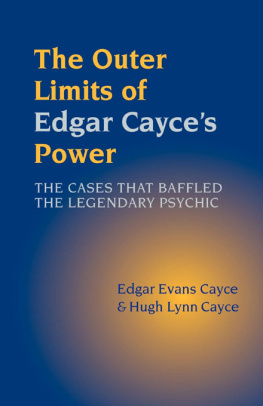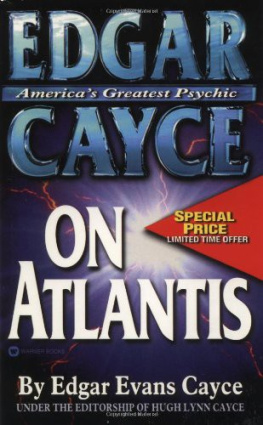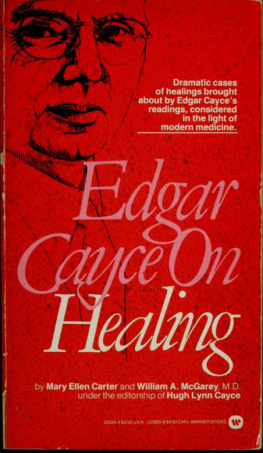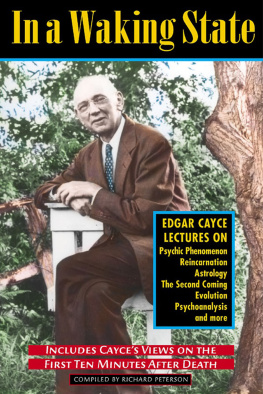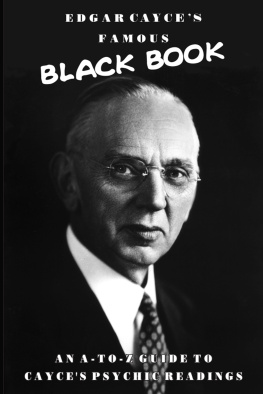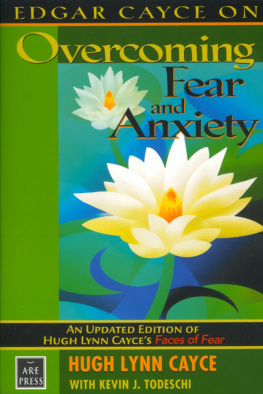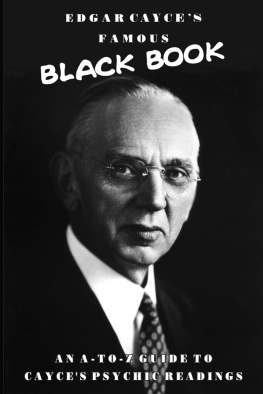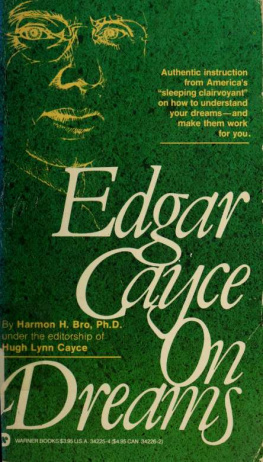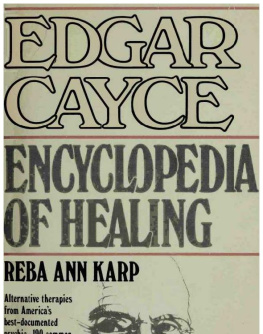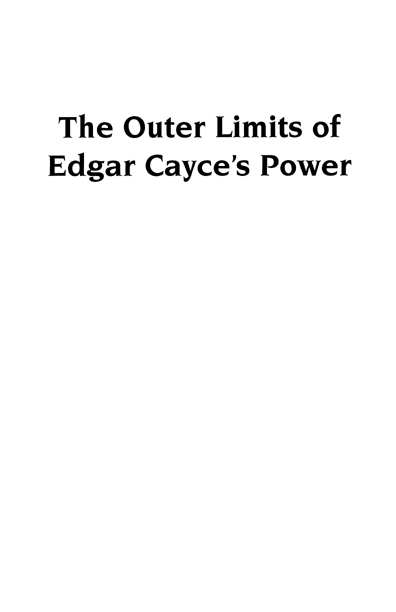The Outer Limits of Edgar Cayces Power
Copyright 2004 Edgar Evans Cayce and Hugh Lynn Cayce
All rights reserved. No part of this book may be used or reproduced in any manner whatsoever without prior written permission except in the case of brief quotations embodied in critical articles or reviews. For information, address Paraview, P.O. Box 416, Old Chelsea Station, New York, NY 10113-0416, or visit our website at www.paraview.com.
The Outer Limits of Edgar Cayces Power was originally published by A.R.E. Press in 1971.
Cover design by smythtype
ISBN: 1-931044-68-6
Library of Congress Catalog Number: 2003113670
PREFACE
Edgar Cayces accuracy as a psychic has been the subject of many books. Some authors have illustrated his astounding ability by documenting cases in which individuals obtained relief from physical suffering. The so-called physical readings, which comprise about 60% of all Cayces readings, are the main source from which their cases were taken. Other authors have selected particular sets of readings, for example those mentioning Atlantis, as the basis for their books. In every instance the accuracy of Cayces statements was stressed. Recent discoveries in the medical, archaeological, and other fields were quoted to show that Cayce was truly on target, if not ahead of his time.
Was Cayce ever wrong? Did he ever give information that was vague, misleading or downright false? What caused this breakdown of his unusual ability? Can we learn anything from his failures?
In this book we examine the Cayce readings that seem to be incorrect. In spite of an estimated 85% accuracy record, about as good as that of most modern doctors, there are readings in the files that must be rated as failures. By examining these few readings we may gain an insight into Cayces psychic talents. Perhaps what we learn may apply to other psychics as well.
It is interesting to note that Edgar Cayces unsuccessful readings stem not so much from the physical or even the life readings, as from a miscellaneous collection of readings which include such diverse subjects as missing people, oil wells, and buried treasure.
In the chapter entitled The Nature of Psychic Perception we look at the probable sources of Edgar Cayces information for clues as to why these particular readings were failures. Since what applies to Cayce in particular probably applies to other psychics in general, this study should help us better understand psychic phenomena.
If a baseball player with a .480 batting average strikes out in one game, he is not written off for the rest of the season. Although the majority of Edgar Cayces readings were accurate, that does not mean they were all accurate. Nor does it follow that because a few were incorrect that they were all incorrect. Two cases that were recently checked, more than fifty years after they were given, may illustrate the point.
In 1925 and again in 1931 Edgar Cayce stated that long ago the Nile River once flowed into the Atlantic Ocean. Back in 1925 and even later in 1931 there was no way to check these pronouncements. It was not until 1986 that radar pictures taken from the space shuttle showed that the old course of the Nile indeed flowed west into the Atlantic instead of maintaining its present direction north into the Mediterranean Sea.
In 1984 charcoal fragments taken from mortar between the blocks of the Great Pyramid of Giza were carbon dated. This was to check statements in several Cayce readings that the Great Pyramid was built about 10,500 B.C. Although the dates from seventeen samples proved to be approximately 400 years older than accepted Egyptian chronologyabout 2500 B.C.none dated back as far as Cayces claim.
Why was Cayce right in one instance and wrong in the other? We dont know. But each case must be judged on its own merits. We should strive to learn from our failures as well as from our successes. We hope you will read this book with that thought in mind.
CHAPTER 1
Successes and Failures
Now you will have before you the body of Vera Smith, who is at 2405 West 7th Street, Dayton, Ohio. You will go over this body carefully, examine it thoroughly, and tell me the conditions you find at the present time; giving the cause of the existing conditions, also the suggestions for the help and relief for this body. You will speak distinctly at a normal rate of speech. You will answer the questions that may be asked.
Gertrude Cayce read this suggestion over again for the fifth time. Her husband lay on the studio couch to her left, his hands crossed over his stomach; a brightly colored afghan that she had crocheted for him was pulled up to his interlaced fingers. His eyes were closed, he breathed regularly and evenly. There was no response from the sleeping man. At a nearby desk, the secretary, Gladys Davis, waited. A calendar on the desk showed the date as Thursday, February 12, 1934.
Edgar Cayceknown today to hundreds of thousands of people as the Sleeping Prophet, to hundreds of people as a good Sunday school teacher, and to us as Dadslept for an hour and a half that day without speaking. This was one of perhaps twelve times over a period of forty-three years when he did not respond to the suggestion that was given to him twice a day on an average of eight times each week.
Hundreds of miles away, in Dayton, Ohio, Vera Smith waited, not knowing exactly what to expect. When she had written to Edgar Cayce in Virginia Beach, Virginia, at the suggestion of a friend who had known about the Cayces when they lived in Dayton, she had been told to state exactly where she would be at 3 p.m. on the afternoon of February 12th. Nothing was asked about her illness. She volunteered no information. In her first letter, she had said, Ive been sick for some time. The doctors seem to disagree on what is wrong. Will you please give me a reading? Within a few days she would receive not a reading, but a short note from Edgar Cayce saying that he had been unable to get the reading. Another date would be given, and again Miss Smith would be asked to say where she would be, this time at 10 a.m. on February 25.
What happened? Why didnt Edgar Cayce follow his regular procedure and talk about this woman? Was something wrong with him, with his wife who gave him the suggestion, with Vera Smith in Dayton, Ohio? Just how accurate were the Edgar Cayce psychic readings? Did he ever make mistakes? If so, was there any explanation for them? What kind of information was likely to be right; what likely to be wrong? These are some of the questions this book will attempt to answer.
Because there are more than 50,000 typewritten pages of stenographic transcripts of Edgar Cayces readings on file in the national headquarters of the Association, and because there are now over 200,000 index cards with subject headings, it is possible to examine what Cayce said on almost any subject.
The Association for Research and Enlightenment in Virginia Beach, Virginia, a psychical research society, preserved and today is continuing to check, compare, and experiment with the data in these readings. In this volume, we will discuss both his successes and failures, touching partly on incidents and types of readings where he seemed to have been wrong. In some ways, his failures tell us more about Edgar Cayce and his psychic reach than an examination of those cases where he was accurate.

